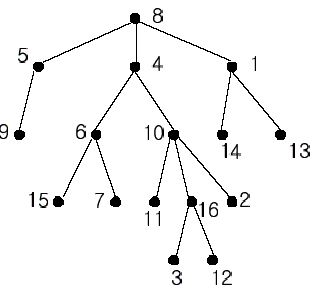| Time Limit: 1000MS | Memory Limit: 10000K | |
| Total Submissions: 21069 | Accepted: 11050 |
Description

In the figure, each node is labeled with an integer from {1, 2,...,16}. Node 8 is the root of the tree. Node x is an ancestor of node y if node x is in the path between the root and node y. For example, node 4 is an ancestor of node 16. Node 10 is also an ancestor of node 16. As a matter of fact, nodes 8, 4, 10, and 16 are the ancestors of node 16. Remember that a node is an ancestor of itself. Nodes 8, 4, 6, and 7 are the ancestors of node 7. A node x is called a common ancestor of two different nodes y and z if node x is an ancestor of node y and an ancestor of node z. Thus, nodes 8 and 4 are the common ancestors of nodes 16 and 7. A node x is called the nearest common ancestor of nodes y and z if x is a common ancestor of y and z and nearest to y and z among their common ancestors. Hence, the nearest common ancestor of nodes 16 and 7 is node 4. Node 4 is nearer to nodes 16 and 7 than node 8 is.
For other examples, the nearest common ancestor of nodes 2 and 3 is node 10, the nearest common ancestor of nodes 6 and 13 is node 8, and the nearest common ancestor of nodes 4 and 12 is node 4. In the last example, if y is an ancestor of z, then the nearest common ancestor of y and z is y.
Write a program that finds the nearest common ancestor of two distinct nodes in a tree.
Input
Output
Sample Input
2 16 1 14 8 5 10 16 5 9 4 6 8 4 4 10 1 13 6 15 10 11 6 7 10 2 16 3 8 1 16 12 16 7 5 2 3 3 4 3 1 1 5 3 5
Sample Output
4 3
最近公共祖先(LCA):
1.这个算法基于并查集和深度优先搜索。算法从根开始,对每一棵子树进行深度优先搜索,访问根时,将创建由根结点构建的集合,然后对以他的孩子结点为根的子树进行搜索,使对于 u, v 属于其某一棵子树的 LCA 询问完成。这时将其所有子树结点与根结点合并为一个集合。 对于属于这个集合的结点 u, v 其 LCA 必定是根结点。
2对于最近公共祖先问题,我们先来看这样一个性质,当两个节点(u,v)的最近公共祖先是x时,那么我们可以确定的说,当进行后序遍历的时候,必然先访问完x的所有子树,然后才会返回到x所在的节点。这个性质就是我们使用Tarjan算法解决最近公共祖先问题的核心思想。
同时我们会想这个怎么能够保证是最近的公共祖先呢?我们这样看,因为我们是逐渐向上回溯的,所以我们每次访问完某个节点x的一棵子树,我们就将该子树所有节点放进该节点x所在的集合,并且我们设置这个集合所有元素的祖先是该节点x。那么到我们完成对一个节点的所有子树的访问时,我们将这个节点标记为已经找到了祖先的点。
这个时候就体现了Tarjan采用离线的方式解决最近公共祖先的问题特点所在了,所以这个时候就体现了这一点。假设我们刚刚已经完成访问的节点是a,那么我们看与其一同被询问的另外一个点b是否已经被访问过了,若已经被访问过了,那么这个时候最近公共祖先必然是b所在集合对应的祖先c,因为我们对a的访问就是从最近公共祖先c转过来的,并且在从c的子树b转向a的时候,我们已经将b的祖先置为了c,同时这个c也是a的祖先,那么c必然是a、b的最近公共祖先。
对于一棵子树所有节点,祖先都是该子树的根节点,所以我们在回溯的时候,时常要更新整个子树的祖先,为了方便处理,我们使用并查集维护一个集合的祖先。总的时间复杂度是O(n+q)的,因为dfs是O(n)的,然后对于询问的处理大概就是O(q)的。
AC代码:
#include<iostream>
#include<cstdio>
#include<cstring>
#include<vector>
using namespace std;
const int maxn = 10001;
int n,fa[maxn];
int rank[maxn];
int indegree[maxn];
int vis[maxn];
vector<int> hash[maxn],Qes[maxn];
int ances[maxn]; //祖先
void init(int n)
{
for(int i=0;i<=n;i++)
{
fa[i] = i;
rank[i] = 0;
indegree[i] = 0;
vis[i] = 0;
ances[i] = 0;
hash[i].clear();
Qes[i].clear();
}
}
int find(int x)
{
if(x != fa[x])
{
fa[x] = find(fa[x]);
}
return fa[x];
}
void Union(int x,int y)
{
int fx = find(x);
int fy = find(y);
if(fx == fy) return;
if(rank[fy] < rank[fx])
{
fa[fy] = fx;
}
else
{
fa[fx] = fy;
if(rank[fx] == rank[fy])
{
rank[fy]++;
}
}
}
void Tarjan(int u)
{
ances[u] = u; //初始化u的祖先为自己
int i,size = hash[u].size(); //几个分支
for(i=0;i<size;i++)
{
Tarjan(hash[u][i]); //递归处理儿子
Union(u,hash[u][i]); //将儿子父亲合并,合并时会将儿子的父亲改为u
ances[find(u)] = u; //当前结点设置为这个集合的祖先
}
vis[u] = 1;
//查询
size = Qes[u].size();
for(i=0;i<size;i++)
{
if(vis[Qes[u][i]] == 1) //即查询的另一个结点开始已经访问过,当前u在此回合访问
{
printf("%d\n",ances[find(Qes[u][i])]); //由于递归,此时还是在u
return;
}
}
}
int main()
{
int t;
int i,j;
//freopen("1.txt","r",stdin);
cin>>t;
while(t--)
{
scanf("%d",&n);
init(n);
int s,d;
for(i=1;i<=n-1;i++)
{
scanf("%d%d",&s,&d);
hash[s].push_back(d);
indegree[d]++; //入度+1
}
scanf("%d%d",&s,&d); //这里可以输入多组询问
Qes[s].push_back(d);
Qes[d].push_back(s);
for(j=1;j<=n;j++)
{
if(indegree[j] == 0) //根结点
{
Tarjan(j);
break;
}
}
}
return 0;
}

























 448
448

 被折叠的 条评论
为什么被折叠?
被折叠的 条评论
为什么被折叠?








